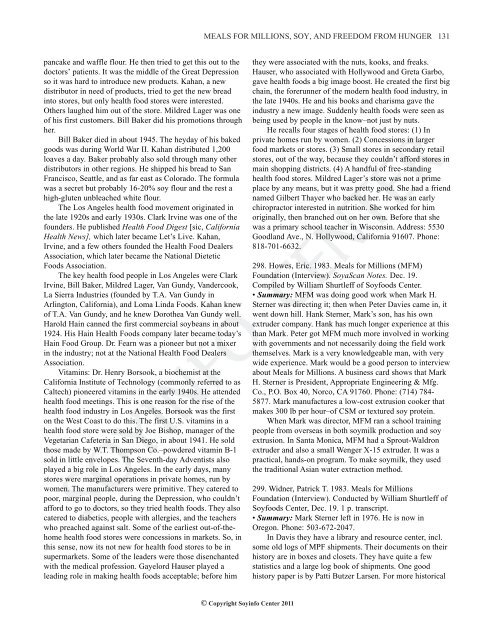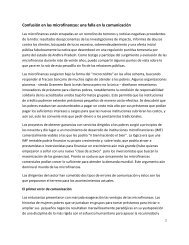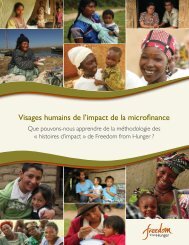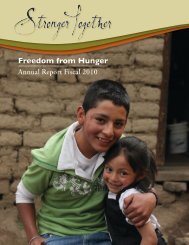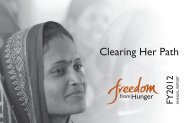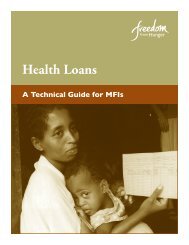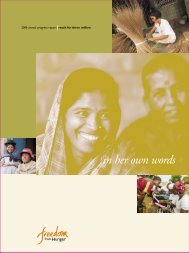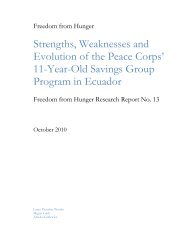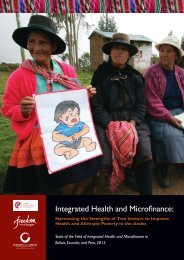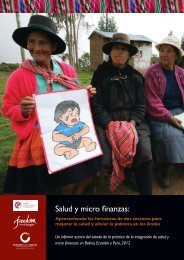history of meals for millions, soy, and freedom from ... - SoyInfo Center
history of meals for millions, soy, and freedom from ... - SoyInfo Center
history of meals for millions, soy, and freedom from ... - SoyInfo Center
You also want an ePaper? Increase the reach of your titles
YUMPU automatically turns print PDFs into web optimized ePapers that Google loves.
pancake <strong>and</strong> waffle flour. He then tried to get this out to the<br />
doctors’ patients. It was the middle <strong>of</strong> the Great Depression<br />
so it was hard to introduce new products. Kahan, a new<br />
distributor in need <strong>of</strong> products, tried to get the new bread<br />
into stores, but only health food stores were interested.<br />
Others laughed him out <strong>of</strong> the store. Mildred Lager was one<br />
<strong>of</strong> his first customers. Bill Baker did his promotions through<br />
her.<br />
Bill Baker died in about 1945. The heyday <strong>of</strong> his baked<br />
goods was during World War II. Kahan distributed 1,200<br />
loaves a day. Baker probably also sold through many other<br />
distributors in other regions. He shipped his bread to San<br />
Francisco, Seattle, <strong>and</strong> as far east as Colorado. The <strong>for</strong>mula<br />
was a secret but probably 16-20% <strong>soy</strong> flour <strong>and</strong> the rest a<br />
high-gluten unbleached white flour.<br />
The Los Angeles health food movement originated in<br />
the late 1920s <strong>and</strong> early 1930s. Clark Irvine was one <strong>of</strong> the<br />
founders. He published Health Food Digest [sic, Cali<strong>for</strong>nia<br />
Health News], which later became Let’s Live. Kahan,<br />
Irvine, <strong>and</strong> a few others founded the Health Food Dealers<br />
Association, which later became the National Dietetic<br />
Foods Association.<br />
The key health food people in Los Angeles were Clark<br />
Irvine, Bill Baker, Mildred Lager, Van Gundy, V<strong>and</strong>ercook,<br />
La Sierra Industries (founded by T.A. Van Gundy in<br />
Arlington, Cali<strong>for</strong>nia), <strong>and</strong> Loma Linda Foods. Kahan knew<br />
<strong>of</strong> T.A. Van Gundy, <strong>and</strong> he knew Dorothea Van Gundy well.<br />
Harold Hain canned the first commercial <strong>soy</strong>beans in about<br />
1924. His Hain Health Foods company later became today’s<br />
Hain Food Group. Dr. Fearn was a pioneer but not a mixer<br />
in the industry; not at the National Health Food Dealers<br />
Association.<br />
Vitamins: Dr. Henry Borsook, a biochemist at the<br />
Cali<strong>for</strong>nia Institute <strong>of</strong> Technology (commonly referred to as<br />
Caltech) pioneered vitamins in the early 1940s. He attended<br />
health food meetings. This is one reason <strong>for</strong> the rise <strong>of</strong> the<br />
health food industry in Los Angeles. Borsook was the first<br />
on the West Coast to do this. The first U.S. vitamins in a<br />
health food store were sold by Joe Bishop, manager <strong>of</strong> the<br />
Vegetarian Cafeteria in San Diego, in about 1941. He sold<br />
those made by W.T. Thompson Co.–powdered vitamin B-1<br />
sold in little envelopes. The Seventh-day Adventists also<br />
played a big role in Los Angeles. In the early days, many<br />
stores were marginal operations in private homes, run by<br />
women. The manufacturers were primitive. They catered to<br />
poor, marginal people, during the Depression, who couldn’t<br />
af<strong>for</strong>d to go to doctors, so they tried health foods. They also<br />
catered to diabetics, people with allergies, <strong>and</strong> the teachers<br />
who preached against salt. Some <strong>of</strong> the earliest out-<strong>of</strong>-thehome<br />
health food stores were concessions in markets. So, in<br />
this sense, now its not new <strong>for</strong> health food stores to be in<br />
supermarkets. Some <strong>of</strong> the leaders were those disenchanted<br />
with the medical pr<strong>of</strong>ession. Gayelord Hauser played a<br />
leading role in making health foods acceptable; be<strong>for</strong>e him<br />
MEALS FOR MILLIONS, SOY, AND FREEDOM FROM HUNGER 131<br />
© Copyright Soyinfo <strong>Center</strong> 2011<br />
they were associated with the nuts, kooks, <strong>and</strong> freaks.<br />
Hauser, who associated with Hollywood <strong>and</strong> Greta Garbo,<br />
gave health foods a big image boost. He created the first big<br />
chain, the <strong>for</strong>erunner <strong>of</strong> the modern health food industry, in<br />
the late 1940s. He <strong>and</strong> his books <strong>and</strong> charisma gave the<br />
industry a new image. Suddenly health foods were seen as<br />
being used by people in the know–not just by nuts.<br />
He recalls four stages <strong>of</strong> health food stores: (1) In<br />
private homes run by women. (2) Concessions in larger<br />
food markets or stores. (3) Small stores in secondary retail<br />
stores, out <strong>of</strong> the way, because they couldn’t af<strong>for</strong>d stores in<br />
main shopping districts. (4) A h<strong>and</strong>ful <strong>of</strong> free-st<strong>and</strong>ing<br />
health food stores. Mildred Lager’s store was not a prime<br />
place by any means, but it was pretty good. She had a friend<br />
named Gilbert Thayer who backed her. He was an early<br />
chiropractor interested in nutrition. She worked <strong>for</strong> him<br />
originally, then branched out on her own. Be<strong>for</strong>e that she<br />
was a primary school teacher in Wisconsin. Address: 5530<br />
Goodl<strong>and</strong> Ave., N. Hollywood, Cali<strong>for</strong>nia 91607. Phone:<br />
818-701-6632.<br />
298. Howes, Eric. 1983. Meals <strong>for</strong> Millions (MFM)<br />
Foundation (Interview). SoyaScan Notes. Dec. 19.<br />
Compiled by William Shurtleff <strong>of</strong> Soyfoods <strong>Center</strong>.<br />
• Summary: MFM was doing good work when Mark H.<br />
Sterner was directing it; then when Peter Davies came in, it<br />
went down hill. Hank Sterner, Mark’s son, has his own<br />
extruder company. Hank has much longer experience at this<br />
than Mark. Peter got MFM much more involved in working<br />
with governments <strong>and</strong> not necessarily doing the field work<br />
themselves. Mark is a very knowledgeable man, with very<br />
wide experience. Mark would be a good person to interview<br />
about Meals <strong>for</strong> Millions. A business card shows that Mark<br />
H. Sterner is President, Appropriate Engineering & Mfg.<br />
Co., P.O. Box 40, Norco, CA 91760. Phone: (714) 784-<br />
5877. Mark manufactures a low-cost extrusion cooker that<br />
makes 300 lb per hour–<strong>of</strong> CSM or textured <strong>soy</strong> protein.<br />
When Mark was director, MFM ran a school training<br />
people <strong>from</strong> overseas in both <strong>soy</strong>milk production <strong>and</strong> <strong>soy</strong><br />
extrusion. In Santa Monica, MFM had a Sprout-Waldron<br />
extruder <strong>and</strong> also a small Wenger X-15 extruder. It was a<br />
practical, h<strong>and</strong>s-on program. To make <strong>soy</strong>milk, they used<br />
the traditional Asian water extraction method.<br />
299. Widner, Patrick T. 1983. Meals <strong>for</strong> Millions<br />
Foundation (Interview). Conducted by William Shurtleff <strong>of</strong><br />
Soyfoods <strong>Center</strong>, Dec. 19. 1 p. transcript.<br />
• Summary: Mark Sterner left in 1976. He is now in<br />
Oregon. Phone: 503-672-2047.<br />
In Davis they have a library <strong>and</strong> resource center, incl.<br />
some old logs <strong>of</strong> MPF shipments. Their documents on their<br />
<strong>history</strong> are in boxes <strong>and</strong> closets. They have quite a few<br />
statistics <strong>and</strong> a large log book <strong>of</strong> shipments. One good<br />
<strong>history</strong> paper is by Patti Butzer Larsen. For more historical


